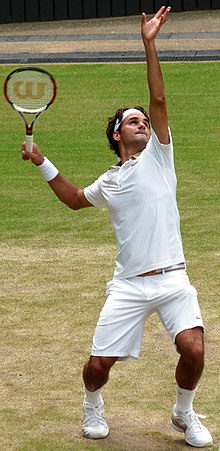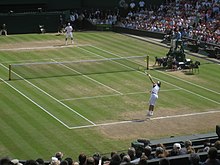 Roger Federer (born 8 August 1981) is a Swiss professional tennis player who, as of November 2013, is ranked world no. 6 by the ATP.
Numerous commentators, pundits, and former and current players of the
sport regard Federer as the greatest tennis player of all time.
Roger Federer (born 8 August 1981) is a Swiss professional tennis player who, as of November 2013, is ranked world no. 6 by the ATP.
Numerous commentators, pundits, and former and current players of the
sport regard Federer as the greatest tennis player of all time.He holds several men's world records of the Open Era: holding the world no. 1 position for 302 weeks overall; including a 237-consecutive-week stretch at the top from 2004 to 2008; winning 17 Grand Slam singles titles; reaching the finals of each Grand Slam tournament at least five times (an all-time record); and reaching the Wimbledon final eight times. He is one of seven men, and one of four in the Open Era, to capture the career Grand Slam. Federer also shares the Open Era record for most titles at the Australian Open with Agassi and Novak Djokovic (4), at Wimbledon with Pete Sampras (7) and at the US Open with Jimmy Connors and Sampras (5).
Federer has appeared in 24 men's Grand Slam finals, with 10 in a row, both records, and appeared in 18 of 19 finals from the 2005 Wimbledon Championships through to the 2010 Australian Open. He is the only man to reach at least the semifinals of 23 consecutive Grand Slam tournaments, from the 2004 Wimbledon Championships through the 2010 Australian Open. At the 2013 Australian Open, he reached a record 33rd Grand Slam semi-final, and at the 2013 French Open a record 36th consecutive Grand Slam quarter-final. He has also won the most matches, 260, in men's Grand Slam tournaments.
Federer's ATP tournament records include winning six ATP World Tour Finals, playing in the finals at all nine ATP Masters 1000 tournaments (a record shared with Djokovic and Nadal), and having won the most prize money of any player in history, with over $78,000,000. He also won the Olympic gold medal in doubles with his compatriot Stanislas Wawrinka at the 2008 Summer Olympic Games and the Olympic silver medal in singles at the 2012 Summer Olympic Games. He spent eight years (2003–2010) continuously in the top 2 in the year-end men's rankings and ten (2003–2012) in the top 3. Federer is the first tennis player, male or female, to earn more than 50 million US dollars in prize money.
Federer has won the ATPWorldTour.com Fans' Favourite Award a record eleven times straight (2003–2013) and the Stefan Edberg Sportsmanship Award (voted for by the players) a record nine times (2004–2009, 2011–2013), both being awards indicative of respect and popularity. He also won the Arthur Ashe Humanitarian of the Year Award twice in 2006 and 2013. He was named the Laureus World Sportsman of the Year for a record four consecutive years (2005–2008). Federer is at times referred to as the Federer Express, shortened to Fed Express or FedEx, and the Swiss Maestro, or just Maestro. Federer is the first Swiss male player to win a grand slam tournament.
Rivalries
Federer vs. Nadal

They held the top two rankings on the ATP Tour from July 2005 until 17 August 2009, when Nadal fell to world no. 3 (Andy Murray became the new No. 2). They are the only pair of men to have ever finished six consecutive calendar years at the top. Federer was ranked no. 1 for a record 237 consecutive weeks beginning in February 2004. Nadal, who is five years younger, ascended to no. 2 in July 2005 and held this spot for a record 160 consecutive weeks, before surpassing Federer in August 2008.
Nadal leads their head-to-head 23–10. Of their 33 matches, 15 have been on clay, which is by far Nadal's best surface. Federer has a winning record on grass (2–1) and indoor hard courts (4–1), while Nadal leads the outdoor hard courts (8–2) and clay (13–2). Because tournament seedings are based on rankings, 20 of their matches have been in tournament finals which have included an all-time record eight Grand Slam finals. From 2006 to 2008, they played in every French Open and Wimbledon final. They then met in the 2009 Australian Open final and the 2011 French Open final. Nadal won six of the eight, losing the first two Wimbledon finals. Three of these finals were five set-matches (2007 and 2008 Wimbledon, 2009 Australian Open), with the 2008 Wimbledon final being lauded as the greatest match ever by many long-time tennis analysts. Of their 33 meetings, 11 have reached a deciding set. They have also played in a record 10 Masters Series finals (tied with Nadal-Djokovic finals), including their lone five-hour match at the 2006 Rome Masters which Nadal won in a fifth-set tie-break, having saved two match points.
Federer vs. Djokovic
Federer and Djokovic have met 31 times with Federer leading 16–15. Federer leads 1–0 on grass. They are tied 12–12 on hard-courts and 3–3 on clay. The Federer–Djokovic rivalry is the largest rivalry in Grand Slam history with a record 11 matches played against each other and Federer leading 6–5. Djokovic is the only player besides Nadal to defeat Federer in consecutive Grand Slam tournaments (2010 US Open and 2011 Australian Open), and the only player besides Nadal and Murray who has double-figure career wins over Federer. Djokovic is one of two players (the other again being Nadal) currently on tour to have defeated Federer in straight sets at a Grand Slam (2008 Australian Open, 2011 Australian Open, 2012 French Open) and the only player to do so three times. Of their 29 meetings, 11 have reached a deciding set.Federer ended Djokovic's perfect 41–0 start to the 2011 season in the semifinals of the French Open, but Djokovic was able to avenge this loss at the 2011 US Open in five sets after saving two match points against Federer for the second straight year. In the semifinal of Wimbledon 2012, Federer beat defending champion and world no. 1 Djokovic in four sets. Many experts have included the rivalry between Federer and Djokovic as one of the best rivalries in the Open Era.
Federer vs. Murray
Federer and Andy Murray have met 21 times with the series led 11–10 by Murray. Murray leads 10–9 on hard courts, and they are tied 1–1 on grass. The two have met five times at the Grand Slam level, the first three times in the finals, Federer winning all three of these matches; at the 2008 US Open and the 2010 Australian Open, both of which he won in straight sets, and at the 2012 Wimbledon Championships in which Murray took the opening set, but went on to lose in four sets. However, Murray won their encounter in the semifinals of the 2013 Australian Open, defeating the Swiss for the first time at a Grand slam tournament in five sets. At the 2014 Australian Open, Federer reversed that result, defeating Murray in four sets in the quarterfinals.They met in the final of the 2012 Summer Olympic Games, in which Murray defeated Federer in straight sets, denying the Swiss maestro a career Golden Slam. Murray also leads 6–1 in ATP 1000 tournaments, 2–0 in finals. They have also met four times at the ATP World Tour Finals with Murray winning in Shanghai in 2008, and Federer in London in 2009, 2010, and 2012. Apart from Rafael Nadal, Murray is the only other active player to have a positive head-to-head record against Federer, as well as being one of only three players to have recorded 10 or more victories over Federer (the other two being Nadal and Novak Djokovic).
Federer vs. Roddick
Main article: Federer–Roddick rivalry
One of Federer's longstanding rivalries was with American Andy Roddick.
Roddick lost his world no. 1 ranking to Federer after Federer won his
first Australian Open in 2004. Federer and Roddick have met on 24
occasions, including in four Grand Slam finals (three at Wimbledon and
one at the US Open). Federer leads 21–3, making Roddick the ATP player
with the most tournament losses to Federer.In the 2009 Wimbledon final, Roddick lost to Federer in five sets. It included a fifth set of 30 games (a Grand Slam final record) and a match that was over four hours long. In the final game of the deciding set, Roddick's serve was broken for the first time in the match. With that victory, Federer broke Pete Sampras' record of 14 Grand Slam titles.
Federer vs. Safin
Marat Safin and Federer played each other 12 times, with Federer leading 10–2. Federer and Safin turned pro within one year of each other, with Safin turning pro in 1997 and Federer in 1998. Federer leads 4–1 on hard courts, 3–0 on grass, and 3–0 on clay courts, while Safin leads 1–0 on carpet. Notable meetings include Federer's defeating Safin at the 2002 Hamburg Masters to win the first Masters 1000 title of his career, as well as Federer emerging victorious in the semifinals of the 2004 Tennis Masters Cup, after winning a tiebreak 20–18 on his eighth match point. Federer also defeated Safin in the finals of the 2004 Australian Open to capture his first Australian Open and second Grand Slam title. However, Safin defeated Federer in the 2005 Australian Open semifinals, having saved one match point in the fourth-set tiebreak, to end a 26-match winning streak by Federer. They met each other five times in Grand Slams, with Federer leading 4–1.Playing style

Federer is an all-court, all-round player known for his speed, fluid style of play, and exceptional shot making. Federer mainly plays from the baseline but is also comfortable at the net, being one of the best volleyers in the game today. He has a powerful, accurate smash and very effectively performs rare elements in today's tennis, such as backhand smash, half-volley and jump smash (slam dunk). David Foster Wallace compared the brute force of Federer's forehand motion with that of "a great liquid whip", while John McEnroe has referred to Federer's forehand as "the greatest shot in our sport." Federer is also known for his efficient movement around the court and excellent footwork, which enables him to run around shots directed to his backhand and instead hit a powerful inside-out or inside-in forehand, one of his best shots.
Federer plays with a single-handed backhand, which gives him great variety. He employs the slice, occasionally using it to lure his opponent to the net and deliver a passing shot. Federer can also fire topspin winners and possesses a 'flick' backhand with which he can generate pace with his wrist; this is usually used to pass the opponent at the net. His serve is difficult to read because he always uses a similar ball toss, regardless of what type of serve he is going to hit and where he aims to hit it, and turns his back to his opponents during his motion. He is often able to produce big serves on key points during a match. His first serve is typically around 200 km/h (125 mph); however, he is capable of serving at 220 km/h (137 mph). Federer is also accomplished at serve and volleying,and employed this tactic frequently in his early career.
Later in his career Federer added the drop shot to his arsenal and can perform a well-disguised one off both wings. He sometimes uses a between-the-legs shot, which is colloquially referred to as a "tweener" or "hotdog". His most notable use of the tweener was in the semifinals of the 2009 US Open against Novak Djokovic, bringing him triple match point, on which he capitalised for a straight-set victory over the Serb.

This work is licensed under a Creative Commons Attribution-ShareAlike 3.0 Unported License.




 08:00
08:00
 Planet Worldwide
Planet Worldwide


 Posted in:
Posted in:
0 comments:
Post a Comment